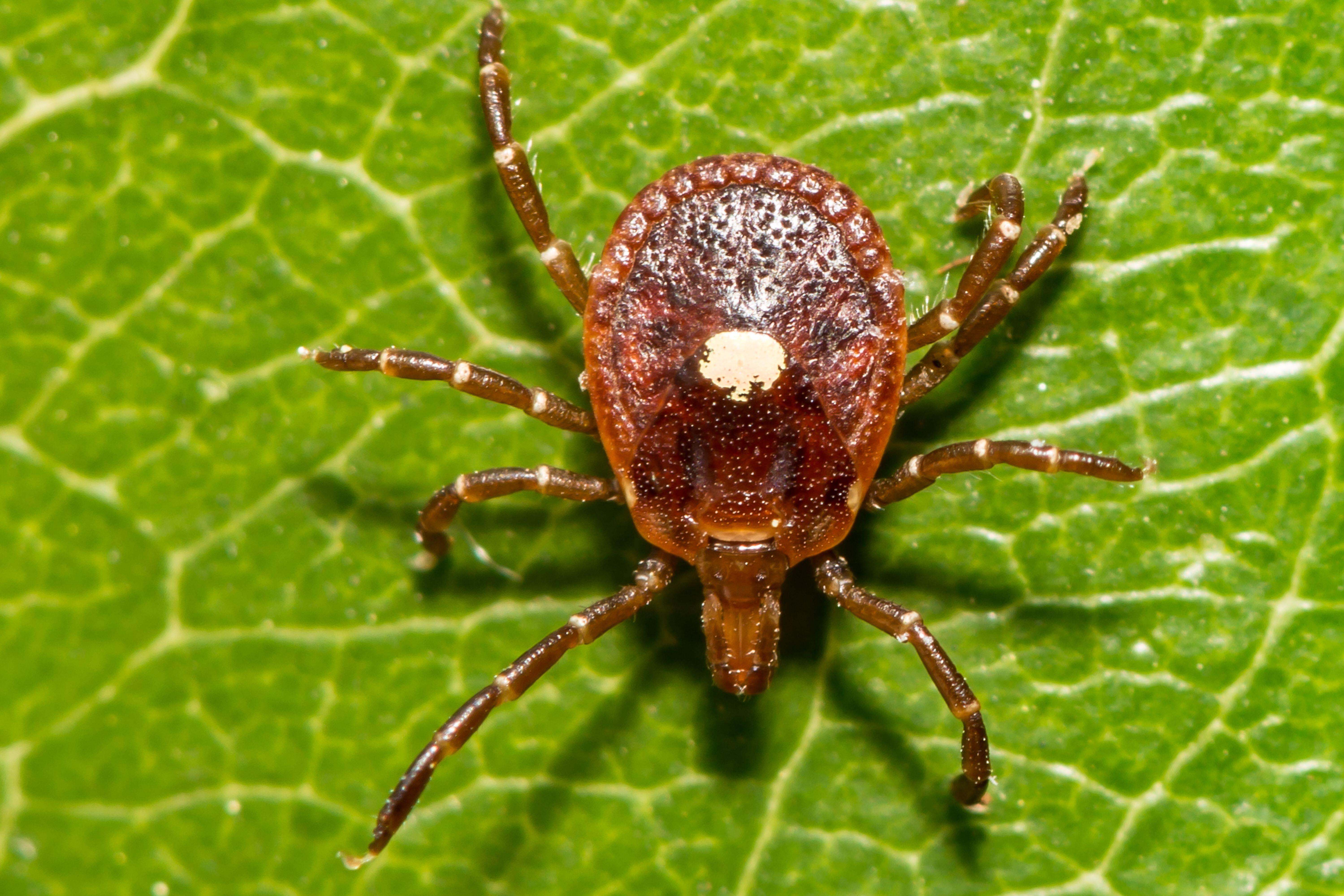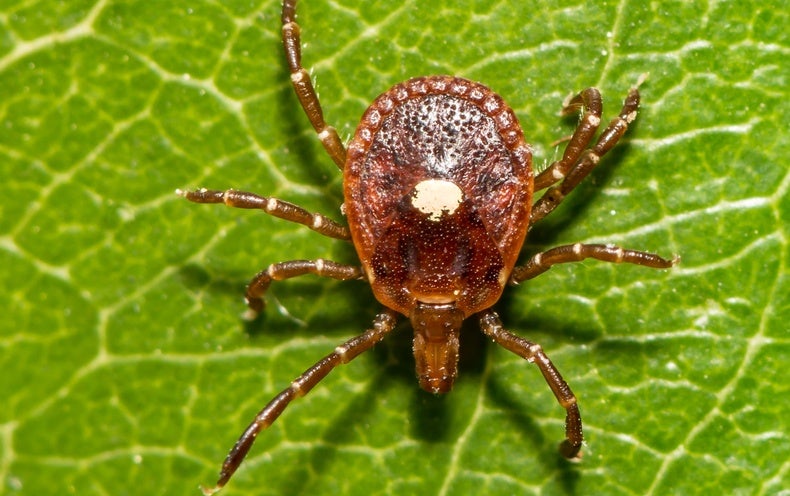
Kristina Carlson didn’t think much about the tick she pulled off her torso while she was hiking in the mountains of North Carolina in September 2020. But back home in Mississippi a month later, Carlson complained to her doctor of aching joints and a bloated feeling in her stomach. Her doctor ruled out rheumatoid arthritis, and a blood test didn’t turn up anything definitive. Then Carlson started having eye infections. In February 2021 she suddenly found a strange rash on her face; an urgent-care facility doctor treated her for shingles, but the rash didn’t get better.
When she returned to her doctor’s office, a nurse practitioner asked, “Do you remember having a tick bite?” This led to another blood test that revealed antibodies associated with alpha-gal, a sugar found in the meat and fat of nonprimate mammals.
Alpha-gal syndrome (AGS) is an allergic reaction that can arise after someone is bitten by a lone star tick. Named for the white dot on the back of adult females, the ticks are historically located in the south central and southeastern U.S. They transmit the alpha-gal molecule from mammals they’ve fed on to people they bite.
Now the ticks are being found in New Jersey and New York State’s Long Island, with sporadic reports farther north along the Eastern Seaboard and in parts of the Midwest. The spread is prompting researchers to consider the potential long-term complications of AGS and to further verify the cause of the allergy using genetically modified meat.
Normally, when a person eats meat from nonprimate mammals, such as cows and pigs, their body does not react to alpha-gal. But when a tick bite introduces the molecule, the immune system recognizes it as an invader and produces antibodies known as immunoglobulin E (IgE) tailored against it. IgE antibodies attach to disease-fighting white blood cells called basophils in the bloodstream and mast cells in tissues. The next time those cells come into contact with alpha-gal from any source, including meat, the antibodies recognize it, and the immune system attacks it.
Forming IgE “can be thought of as loading the gun,” explains Scott Commins, associate chief for allergy and immunology at the University of North Carolina School of Medicine and a leading AGS researcher. “Eating mammalian meat subsequently pulls the trigger.”
The resulting allergic reactions, which typically begin two to six hours after ingesting alpha-gal, vary from person to person. They can be as mild as a tingling in the mouth or as extreme as anaphylactic shock. Some people with AGS can eat a double cheeseburger and experience only light itching of their palms or scattered hives. Others who consume a trace amount of pork fat in refried beans can go into full anaphylaxis. After eating meat, Carlson would immediately experience tingling and sometimes sores in her mouth. Within 24 hours, she would often suffer eye irritation, joint inflammation, rashes on different parts of her body and swelling in her left arm.
There is currently no treatment or antidote for AGS itself. Epinephrine is the first-line treatment for anaphylaxis, and some other allergic reactions can be managed with medications, including antihistamines and corticosteroids. People with the condition have to try their best to avoid any triggering foods. Eliminating mammalian meat and other products typically allows the symptoms to clear. “I cut all the hoofed animal products,” Carlson says, “and the rash, the infection, the joint [pain], the inflammation all went away.”
One consolation for Carlson and most of the 34,000 other Americans diagnosed with AGS is that the meat sensitivity does not appear to be permanent and often resolves in four to five years. That’s because the immune system cells that create the IgE response are immature B cells called plasmablasts. These cells, according to Commins, do not seem to convert to long-term immune memory cells that remain on the lookout during a person’s entire life—the way immune memory cells triggered by certain vaccines watch for invaders for decades.
People who spend a lot of time outdoors, such as park rangers and land surveyors, might get repeated tick bites, however. “Those patients seem to develop long-lived memory cells,” Commins says. “For them, unfortunately, the alpha-gal allergy probably is permanent.”
As the prevalence of lone star ticks increase, however, AGS cases are expected to rise. “The ticks do appear to be spreading,” says Richard S. Ostfeld, a disease ecologist and a distinguished senior scientist at the Cary Institute of Ecosystem Studies. “Unfortunately, the United States doesn’t have any kind of reasonable tick surveillance program.” Spotty records suggest the lone star ticks’ range is expanding, he says, “but we lack high-quality rigorous data on where they are and how quickly they’re moving.”
Why they are spreading is also hard pin down. The main hypothesis involves climate change, but researchers are hesitant to make that conclusion because it is difficult to test rigorously. “There are studies that suggest that, as the climate continues to warm, the geographic range of the lone star tick will not expand,” Ostfeld says, “although most studies suggest that it will.”
What is clear is that a changing climate is lengthening the active season for at least some ticks, raising the chance that people will cross paths with these arachnids in general. For black-legged ticks in New York State, Ostfeld says, “we’ve demonstrated that both the larval and the nymphal stages have been appearing earlier and earlier as the climate warms. To the extent that lone star ticks behave similarly, you would expect that their active season would get longer.”
Lone star ticks are less than an eighth of an inch long and very aggressive. Often found in large groups, they can detect the heat and carbon dioxide given off by humans from a couple of yards away. Then “they kind of hunt you down,” Ostfeld says. “They actually run at you.”
Researchers would like to find out if alpha-gal IgE might contribute to or exacerbate other conditions. In a small 2018 study, Commins and his colleagues associated the antibody with unstable plaques in coronary arteries. In a larger 2022 study that Commins was not part of, researchers associated heart attacks with a positive blood test for alpha-gal allergy. “We’re trying to understand if this alpha-gal immune response is part of a larger picture,” Commins says.
He is also talking with a biotechnology subsidiary of United Therapeutics called Revivicor, which raises pigs to provide organs for transplant into humans. The animals are genetically modified to be free of alpha-gal because the sugar also causes the human body to reject pig organs. In 2020 the U.S. Food and Drug Administration approved the meat of these “GalSafe” pigs for consumption. For the past few months, Revivicor has been sending the meat to people who suffer from the allergy, and it is considering a mail order business.
Commins would like to test people who eat GalSafe pig meat. If the alpha-gal molecule has been eliminated but the people still react to the meat, researchers would have to reconsider the apparent cause of AGS. “We’re confident that it’s alpha-gal,” Commins says, “but I think this would really prove it.”



























































